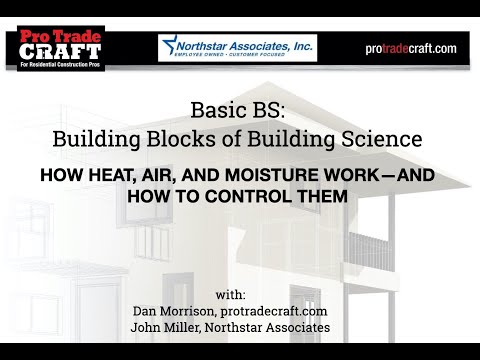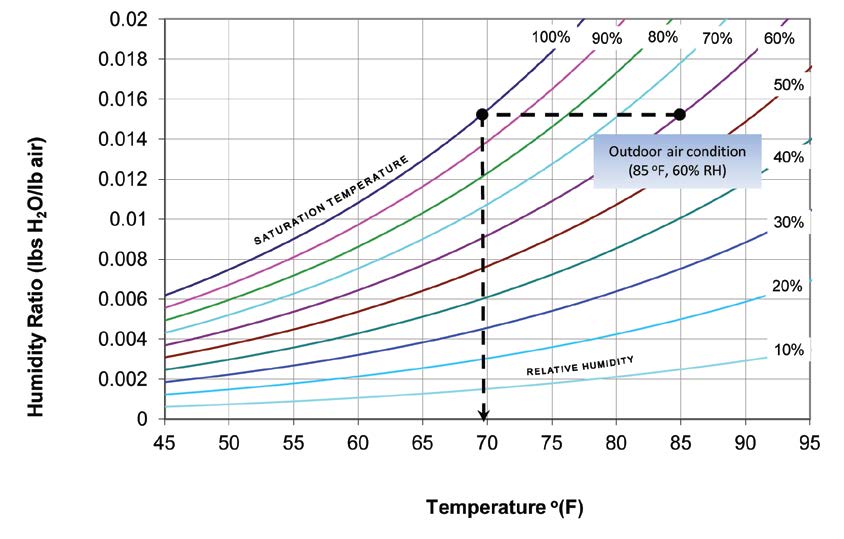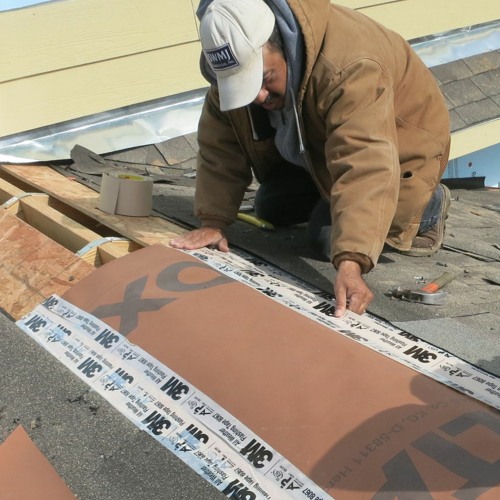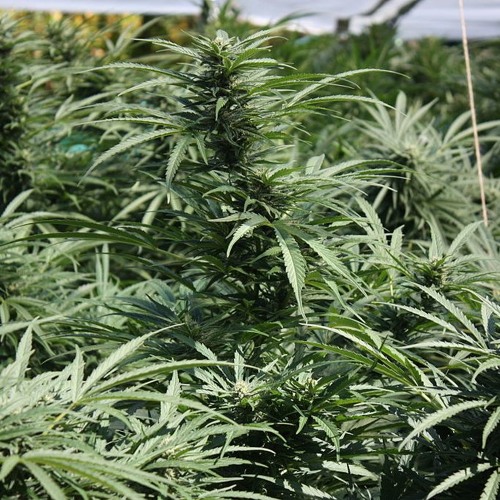We are joined this time by Dr. Allison Bailes, aka, the Energy Vanguard. Allison and I sat down after a day of classes at The Westford Symposium on Building Science (aka, Building Science Summer Camp) to discuss the topic of a recent article he wrote on the Energy Vanguard blog.
What dew point is
dew point
ˈd(y)o͞o point (n)
Dew point is the temperature at which water vapor in the air will condense on surfaces.
—Dr. Allison Bailes
"So, if you have a surface that is at the dew point temperature of the water vapor that’s in the space around that surface, the water vapor will start condensing on that surface."
When warm air rubs up against a cold surface, moisture moves in.
How dew point works
Technically, air doesn’t hold water; they hang together. Water vapor is a gas, and air is a gas; the two are gassy in the same space. When they start chillin’, water vapor is less gassy and more splashy.
Because lower temperatures support less water vapor.
If you think about one of the cold cups of beer that Allison and I were enjoying during the August heat at Building Science Summer Camp, then you are probably picturing a cup with great beer on the inside, and a thin layer of moisture on the outside.
Condensation.
The warm moist air directly next to the cup is cooled below the dew point temperature, so liquid left on the cold surface.
The dew point right next to the cup is the same as the dew point a foot away from the cup. But the relative humidity is much different. Relative humidity measures the amount of water vapor relative to the amount of air in a space.
"Dew Point, though, is a measure of how much actual water vapor is there, it is a measure of the concentration of water vapor in the air. So the higher the dew point, the more water vapor molecules are in the air."
People are probably more familiar with thinking about it as it relates to weather than about how it affects my cup of beer at summer camp.
"So here's what people get confused about that. they know that in the mornings, and they look at the weather on TV or on an app, and they see that 'Oh, it's 90% relative humidity or 95% or even 100% relative humidity—that does happen. But at the time they see that relative humidity, it may be temperature may be 70. otr 75, or 78 maybe if you're on the gulf coast somewhere.
It's not high humidity and high temperature at the same time. As the day warms up, and the temperature gets up, maybe ibnto the nineties, the relative humidity is dropping all through that time that it's warming up."
Because the amount of water vapor in the space around you depends on temperature. Warmer temperatures mean more vapor can fit, so the relative fullness of the bucket gets smaller.
"And so that’s why if you look at the dew point, it gives you a better idea of, OK, is this a muggy day or not? In the morning whan it's ninety percent relative hiumidity, yeah, its muggy at that time, but will it be muggy in the afternoon when iot is ninety degrees?"
A Ph.D. who owns an HVAC company in GA ought to know about a muggy day. Not only does he get worked up about relative humidity, but he can also get pretty worked up about relative hyperbole, too
"I have people talking to me all the time, and sometimes these are people who should know better. And they tell me, 'Oh, where I live we get ninety degrees and ninety percent relative humidity.' I had a builder tell me it gets to 98 degrees at 5% relative humidity where we are.
Which is impossible—well, it's niot impossible, but it has not happened, at least in recorded meteorological history. Because the record dew point is 95 degrees F in Saudi Arabia, and the United States, the record dew point is 91 degrees F.
A 98 degree, 95% relative humidity would probably be about a 96 degree dew point maybe, so it would break the world record if he got theat,"
Is it just me or did it seem like he was calculating the dew point in his head?
He can also juggle, not that it matters.
Why dew point matters
But dew point matters because,
"It matters because condensation is important, and we are hear at building science summer camp and John Straube spoke this morning, Professor Straube gave a great talk on moisture physics.
And, one of the things he talked about this morning was condensation inside walls on exterior sheathing in cold climates."
The exterior sheathing is cold in cold climates because—it is a cold climate. The temperature is progressively warmer as you move toward the inside surface of the wall, where moist, humid air begins the journey to the cold sheathing.
"And water vapor from inside the house can migrate into that wall cavity, and you get condensation and mold growth.
This is a common cold climate problem. You take a hot shower, and the warm moist air gets sucked through cracks in the wall and ices up the inside surface of the wall sheathing.
Now, what professor Straube was saying today was that actually, Houston is a worse climate for condensation in walls, than Burlington, Vermont, because when that water vapor in Burlington, VT finds that cold sheathing, the temperatures are cold.
And, yes, mold CAN grow but it grows a lot more slowly when its cold than the temperatures that you have in Houston in the summertime."
I don’t want to imply that things are backward in either Burlington or Houston, but the general moisture flow is sort of reversed in those places.
Moisture always moves from more to less and from warmer to cooler.
Well, let’s get into phase changes! So, air is mostly made up of things that do not go in and out of different phases: nitrogen, oxygen, carbon dioxide—those things are gasses at the normal temperatures and pressures that we live in. Water, however, goes through all three phases in the pressures and temperatures that we live in.
So, the water vapor in the air will change into the liquid state if it finds a cold enough surface. The reason for that is that the water vapor in the air has a bunch of energy that's zipping around in the air,
That energy in the form of heat.
"And to turn that water vapor into liquid, it has to have that energy removed."
Cold sucks the heat out
"Cold can take that energy out."
Cold literally sucks.
"...and heat transfers from zipping around water vapor molecules, the water vapor molecules accumulate on the cold surfaces, and you get condensation."
In Houston, the warm moist air is outside the building, and the cool, dry air is inside, where the AC is.
"So when the water vapor from exterior air in Houston, leaks into the wall cavity and finds the back of the drywall, which is maybe 75 degrees, and the dew point outside is 80 degrees, you can get condensation on the back of that drywall. The temperature is nice for mold to grow like crazy.
So Houston is worse for condensation issues.
It is better for taco issues; I can personally attest to that.
How to do dew point right
To do dew point right, understand how the moisture moves, and be smarter than the molecule.
"One of the biggest ways to build good assemblies that won’t have condensation problems that grow mold inside the cavities—where you won’t see it until its too late—is air sealing."
Air sealing seems like the answer to every question we have on 7 Minutes of BS.
"Air sealing is the answer to a whole lot of problems, including this one, because most of the time that air leaks into a cavity, it is bringing in a lot more water than the diffusion process."
We’ll cover diffusion in another episode so that the BS in this episode can diffuse into your brain.
Because you get paid for what you do and what you know if you’re already working 80 hours a week, it's time to know more.
Don’t forget to subscribe to this podcast via iTunes, Soundcloud, or The Google. And while you’re there, give us a thumbs-up and a positive review. It helps us get found in the algorithms.
I want to thank Allison Bailes, the Energy Vanguard, for coming on this podcast, and encourage you all to check out his blog, The Energy Vanguard.












